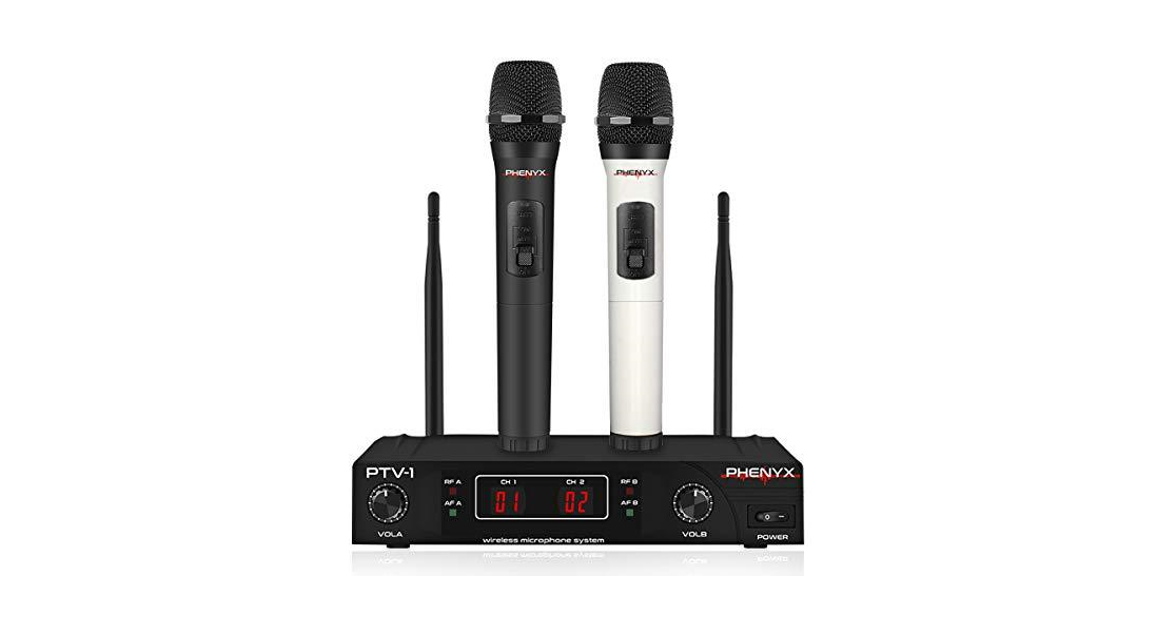
PTV-1VHF DUAL WIRELESS MICROPHONE SYSTEMOWNER’S MANUAL


Thank you for purchasing the PHENYX PTV-1 Dual Wireless Microphone System. Please read this manual carefully to ensure proper use and operation, and keep it for future reference.
System Description
Box Contents
– Dual VHF Wireless receiver with mixed XLR and 1/4″ outputs– 2 Transmitters OR 1 Transmitter and 1 headset and 1 lapel and 1 bodypack– 3′ Audio Cable (1/4″ connectors)– AC adapter– Manual
System Overview
The PTV-1 is a dual wireless microphone system designed to offer great sound quality and ease of use in a compact package. It is very simple to set up and operate, and it is the perfect choice for public address, karaoke, live performances, interviews, sermons, and many more. The signal from the microphones (either handheld, lavalier, or headset, depending on the combination you purchased) is wirelessly transmitted to the receiver, which is connected to your amplifier, mixer, or powered speakers with the included ¾” cable or with a microphone cable with an XLR connector (not included).
Receiver
Front Panel
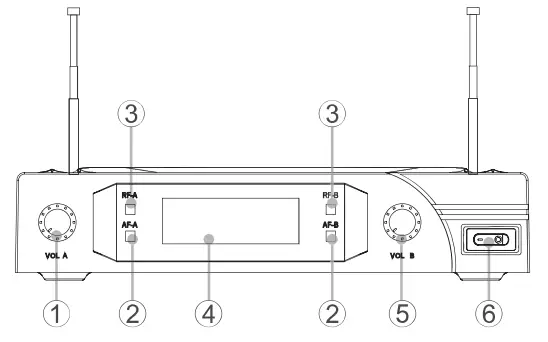

- Channel A volume control
- Audiometer
- RF Meter
- LCD display (power indicator)
- Channel B volume control
- Power switch
Back Panel
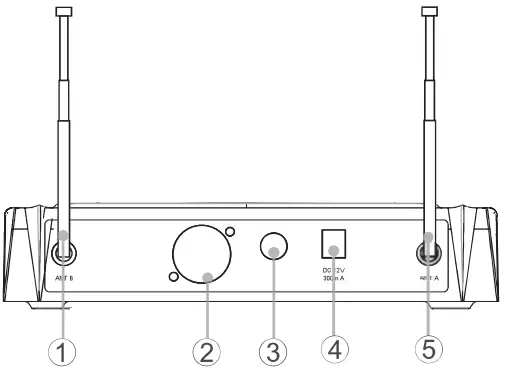

- Antenna B
- Balanced XLR output
- Unbalanced 1/4″ output
- DC input jack
- Antenna A
Transmitters
Handheld Microphone
- Battery power indicator
- ON/MUTE/OFF switch
- Battery compartment cover


Bodypack
The Phenyx VHF bodypack is to be used with the Phenyx lavalier microphones & headsets
- Antenna
- Battery Power Indicator
- ON/MUTE/OFF switch
- Microphone input
- Battery compartment
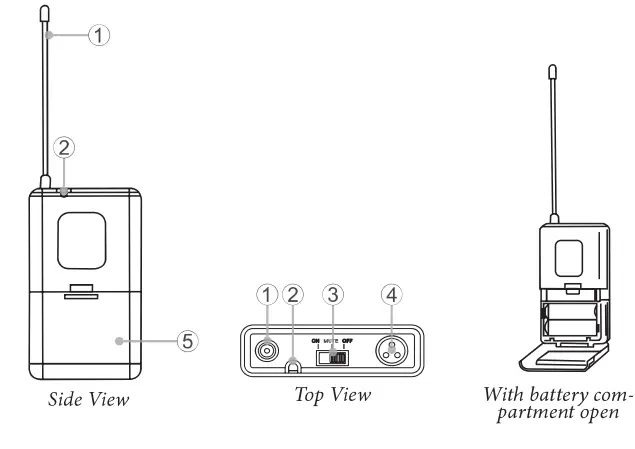

Set-Up:
- Secure the bodypack to clothing, belt, or pocket.
- (a) For a lavalier microphone, clip the microphone to clothing about 1 foot under the mouth. (b) For a headset, install headset comfortably on the head so the microphone can be placed close to the mouth.
- Connect the microphone audio connector to the bodypack microphone input (4)
- Turn the bodypack on by sliding the ON/MUTE/OFF switch to the “ON” position. The battery power indicator (2) will light up briefly, indicating that the batteries have sufficient power.
If the battery power indicator (3) stays continuously on after powering on the bodypack, the batteries must be replaced. To replace the batteries, proceed as follows:– Open the battery compartment door by pushing on the door sides and pulling it open– After removing the old batteries, insert new ones, making sure to respect proper polarity– Close the compartment by gently pushing the compartment door until it clicks
Operating Instructions
Set-Up
- Install fresh batteries in the transmitters (refer to the section relative to the specific transmitter you are using).
- Connect the AC power adapter to a wall outlet and to the back of the receiver.
- Position the antennas 60° apart from each other as shown.

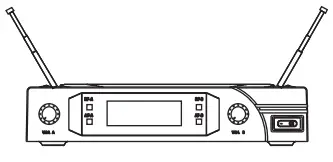
- Connect one of the two outputs available at the back panel to the next stage in your system. Typically, use the 1/4″ output to connect to unbalanced equipment such as consumer-level receivers, amplifiers, and mixers. Connect to professional equipment using the XLR output (cable not included).
- Making sure the volume of your speakers is off, turn on the receiver and the transmitters. The “RF” LED turns on, indicating that the corresponding transmitter is paired with the receiver. Note that the number displayed (the channel number) is fixed and cannot be adjusted. The “AF” LED indicates the presence of an audio signal coming from the transmitter.
- Turn the volume of your speakers back on and start increasing the volume of the transmitters until the proper volume is achieved. The balance between the two microphones can be adjusted with the front panel volume controls.
Operation
For better results, keep the transmitters at least 2′ away from the receiver but within the transmitter’s range (150′). Keep the transmitters in a direct line of sight with the receiver whenever possible. Transmitters can be used one at a time or simultaneously. Use the MUTE position on the transmitter switch to silence the micro-phone without interrupting the pairing with the receiver, which could cause unwanted popping sounds.
Troubleshooting Tips
| ISSUE | REASON | SOLUTION |
| The transmitter battery indicator is rapidly flashing or continuously ON | The batteries are low | Replace with fresh batteries |
| A howling noise (also known as “feedback”) can be heard from the speakers | The microphone is too close to the speaker | Increase the dis-tance between the microphone and the speakerAvoid pointing the microphone directly at the speaker |
| No sound coming to the receiver (AF LED does not light up) | The wireless transmitter is outside of the receiver’s range | Keep wireless microphone within operating range of the receiver |
| The wireless transmitter is off or muted (switch set to “OFF” or “MUTE”) | Turn wireless microphone on (switch set to “ON”). Replace batteries if necessary | |
| Sound reaches the receiver(AF LED lights up) but no sound coming from the receiver | Volume control too low | Turn up the output volume by turning the volume control knobs on the front of the receiver clockwise |
| Output is not (or wrongly) connected | Verify all connections to the rest of your system. Try different connection cables if available |
Specifications
Overall System
Carrier frequency range: VHF(frequency of operation depends on local regulations)Frequency Stability: 0.003%Dynamic Range:>100dBT.H.D: <0.5%Frequency Response: 50Hz-18kHzOutputs: XLR balanced mixed; 1/4″ unbalanced mixedAudio Output Level: 0-500mVRange: 150′ (actual range depends on local conditions)Operating temperature: -10°C–+50°C
Handheld & Bodypack Transmitter
Modulation Mode: FMMaximum Deviation: 75kHzSize:Handheld: 239 x 49 mmBodypack: 110 x 63 x 20 mmWeight (without batteries)Handheld: 181gBodypack: 66gPower requirements: 2 AA alkaline or rechargeable batteries per transmitter Battery life: about 8 hours
ReceiverPower: 5 10mWPower: 5WSIN: >103 dB (1kHz-A)Image Rejection: > 110dBSpurious Rejection: > 90dBSensitivity: -105dBmXLR Output:Pin 1: GroundPin 2: (+)Pin 3: (-)Power: DC12-18V, Current: 400mA, External power adaptor
Technical Support & Warranty Information
Our Warranty to you:
Phenyx Technology (“Phenyx”) warrants Phenyx products against evident defects in material and workmanship for a period of one year from the date of original purchase for use. This warranty is valid exclusively in the US and applies only to the original owner. If you discover a defect covered by this warranty, Phenyx will repair or replace the product at our sole discretion using new or refurbished components. Performance of repairs or replacements under this Warranty is subject to the registration of your product at www.phenyxusa.com/registerproduct.
Product failures not covered by this warranty:
This warranty covers defects in manufacturing that arise from the correct use of the device. It is limited to defects in materials or workmanship and does not cover electrical or mechanical damage resulting from abuse, misuse, unauthorized modification, lack of reasonable care, extreme heat, cold, damage due to natural forces, or corrosive environments. This warranty does not cover the normal wear and tear on covers, housing, connectors, and accessories.
Limits of liability:
If your Phenyx product fails or does not perform as warranted, your sole recourse shall be to replace or repair it as described above. Phenyx will not be liable to you or anyone else for any damages that result from the failure of this product. These damages include, but are not limited to, the following: lost profits, lost savings,
lost data, damage to other equipment, and incidental or consequential damages arising from the use of or inability to use this product. IN NO EVENT PHENYX SHALL BE LIABLE FOR MORE THAN THE AMOUNT OF YOUR PURCHASE PRICE, NOT TO EXCEED THE CURRENT LIST PRICE OF THE PRODUCT.
How to obtain service under this warranty:Please contact us at [email protected] with any questions or concerns about your product and a Phenyx representative will contact you to provide assistance.



www.phenyxusa.comDESIGNED IN U.S.MADE IN CHINA
[xyz-ips snippet=”download-snippet”]

